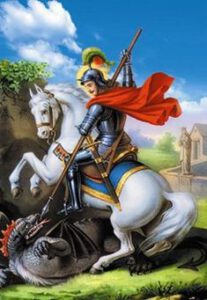
“Do I Need To Worship”? – featuring the Mustard Seed Soul Band from the album “His Story” recorded and produced by Ross Gill
So, tomorrow is St George’s Day – so what do we know of the patron saint of England?
I discovered these interesting facts that I thought I would share.
1) St George was not English – he was actually born in the 3rd century AD – more than 2000 miles away in Cappadocia which is modern day Turkey.
2) Although George is often depicted in popular culture as a knight in shining armour, the truth is less fanciful. Whilst St George was depicted from the 11th century as a chivalric knight or a warrior on horseback, it is more likely that he was an officer in the Roman army.
3) Like many saints, St George was described as a martyr after he died for his Christian faith. It is believed that during the persecutions of the Emperor Diocletian in the early 4th Century, St George was executed from refusing to make a sacrifice in honour of the pagan gods.
4) Although St George never visited England, his reputation for virtue and holiness spread across Europe and his feast day – the 23rd April – was celebrated in England from the 9th century onwards. He became popular with English kings. Edward I (1272-1307) had banners bearing the emblem of St George (a red cross on a white background) and Edward III (1327-77) had a strong interest in the saint and owned a relic of his blood. The St George cross was not used to represent England until the reign of Henry VIII.
5) The story goes that St George rode into Silene (modern day Libya) to free the city from a dragon who had a taste for humans, but it is a story which post dates the real George by several centuries. Images of George and the dragon survive from the 9th century – 500 years after his death. Originally these may simply have been representations of the battle between good and evil, but the story was developed and popularised in the Middle Ages.
6) St George was canonised in AD 494 by Pope Gelasius, who claimed he was one of those ‘whose names are justly revered among men but whose acts are known only to God.’ A feast day of St George has been celebrated in England for hundreds of years on 23 April, which was possibly the date of his martyrdom.
7) England is not the only country or region that claim George as its patron. England shares St George with Venice, Genoa, Portugal, Ethiopia and Catalonia that have their own celebrations and ceremonies in his honour.
8) During the Middle Ages, people believed that St George was one of the ‘Fourteen Holy Helpers’ – a group of saints who could help during epidemic diseases. St George’s protection was invoked against several nasty diseases, many fatal and with infectious causes, including the Plague and leprosy. From around 1100, St George’s help was also sought to protect the English army. In William Shakespeare’s Henry V, the monarch calls on the saint during his battle cry at the Battle of Harfleur in the famous “Once more unto the breach, dear friends” speech, crying “God for Harry! England, and St. George!” Five hundred years later – during the First World War – a ghostly apparition of St George is said to have aided British troops during their retreat from Mons, and the naval commander of the Zeebrugge Raid cited the saint as inspiration.
9) The Order of the Garter (founded by Edward 111 in 1348) is the highest order of chivalry in the country and the St George’s cross appears on the Garter badge and his image is the pendant on the chain. In 1940 King George V! created a new award for acts of the greatest heroism or courage in circumstances of extreme danger. The George Cross named after the King bears the image of St George vanquishing the dragon. The image of St George also adorns many of the memorials built to honour those killed during WW1.
Quote of the week

